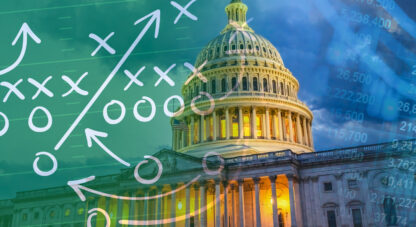The Fed Fiddles as the Economy Burns
There is no shortage of high-impact market-relevant factors in coordinated play at the moment. Last week, markets appeared more concerned with digesting the magnitude of recent inflation data and central bank policy maneuvers. This week, geopolitics and Russia’s invasion of Ukraine took the pole position on the market’s hottest concerns list.
With that said, all of the crucial issues facing markets at present are interrelated. Case in point: Last week, HAI highlighted the critical inflation multiplier that is high energy prices. HAI also outlined the impact that those high energy prices are having in contributing to an ongoing inflationary spike in food prices. Well, in a dramatic plot development, the type usually reserved for the narrative pen of a Hollywood “disaster movie” script writer, this week’s geopolitical events witnessed one the globe’s top three energy producers invading the “breadbasket of Europe.” The momentous development is a humanitarian tragedy, an assault on freedom as well as the political balance-of-power, and threatens to dramatically complicate and exacerbate a growing global inflation crisis.
This week, the extreme volatility of global events was fully reflected in what was, at times, astonishing market volatility and wild price swings in asset classes all across the globe. Make no mistake, the current events board is completely full at the moment, and paints an extremely distressing picture.
Before the Russian invasion of Ukraine, the week started with markets under significant risk-off selling pressure. De-risking, de-leveraging, and a broad market sell-off sent all major market indexes to new lows in the ongoing correction off all-time highs. In fact, after exceeding the 20% decline threshold intraweek, the Nasdaq Composite Index entered into technical bear market territory. By the end of Wednesday, extreme levels of bearish sentiment prevailed and market participants were heavily hedged for a further market crash. At the same time, markets were extremely oversold technically. As late Wednesday turned into Thursday, the news of the Russian invasion initially sent all indexes cratering further and safe-havens surging. Gold shot higher, briefly exceeding $1,976 an ounce, and the VIX volatility index exploded above $37.
All the ingredients were present and ripe for a technical bounce and a relief rally that could trigger an aggressive broad-market short squeeze. Historically these dynamics provide the set-up and staging grounds for sharp and violent market rallies. This holds true even in bear markets—in fact, especially in bear markets. The classic “bear market rally” signature is a surprisingly sharp but brief snapback rally that catches the predominant market positioning off guard. Given the set-up, all that was needed to trigger a massive short squeeze on Thursday was a catalyst.
That catalyst came Thursday afternoon. We were informed that US sanctions on Russia would not include aggressive restrictions on Russian oil exports. If the US had imposed tough, Iranian style sanctions on Russian oil exports, the added stress to an already tight oil market could have been calamitous. Prices for both WTI and Brent crude had already spiked well over $100 per barrel on the news of invasion and on the mere possibility of Russian oil export sanctions and their potential impact to energy markets.
Economists at JPMorgan have covered this scenario best. The bank recently highlighted the risk that Russian oil supply disruptions and aggressive sanctions could quickly send oil prices to $150 per barrel. The severe double-barrel implications this would have toward, on the one hand, accelerating inflation—already at 40-year highs, while on the other hand curtailing global growth would likely carry catastrophic consequences into the global economy and markets. Oil price spikes have a long history of diving economic downturns that result in recession. With the implications to both inflation and growth, it is little surprise that the revelation of an energy carve-out within US sanctions provided all the catalyst a market rally needed. The dramatic upward intraday price reversals on Thursday started a strong rally that received an added boost from reports that Russia might engage in talks with Ukraine. The broad market rally carried straight through to Friday’s closing bell.
Everybody everywhere may have dodged a lethal bullet in avoiding an oil price re-rating to $150 per barrel this week. The impacts of the monumental events of the week will continue to develop and ripple throughout global markets and the economy as the situation unfolds. What is even more clear, however, is that the events of the week are likely to accelerate and accentuate existing dynamics already in place. Impacts on commodity prices may continue to stoke inflation, while inflation’s impact on the consumer may accelerate growth pressures. The Federal Reserve will still have to pick their policy poison. They have to decide whether to aggressively tighten policy to tackle inflation, or whether to protect growth and hope for the best with inflation. Unfortunately, the choice amounts to a high probability lose-lose.
In response to the question of how events in Ukraine this week impact inflation, economic growth, and the policy decisions facing the Federal Reserve, Former Treasury Secretary Larry Summers told Bloomberg, “It’s not good.” He said, “The very difficult job the Fed had already made for itself by falling so far behind the curve [on inflation] has become that much more difficult.” Summers sees the geopolitical developments intensifying inflation as prices rise for oil, energy, and other commodity markets. He also expects that the heavy burden being placed on the backs of consumers will reduce the level of both economic demand and spending as inflation saps consumer purchasing power and slows the economy. The former Treasury Secretary added unambiguously, “the direction is stagflation.”
In his interview, Mr. Summers offered spot-on analysis and an important message that needs to be heard and understood much more readily. As the former Treasury Secretary put it, “The danger is that team transitory will…find further excuse to avoid taking the necessary steps to contain inflation, and therefore postpone the ultimate reckoning, and make more serious what needs to be done to contain inflation. The argument will be made that we can’t afford restrictive policies. The problem is that we also can’t afford an entirely unsustainable economic path that will ultimately set the stage for more stress, more pain… This is a very serious moment, and it’s a moment when policymakers have great responsibility to do things that are not easy.”
Consumer health is a critical component of the macro economic mosaic that is vastly underappreciated. The strength of the consumer may mean the difference between an economy that can withstand a Fed tightening cycle and an economy that buckles as soon as the tightening process begins.
So, what is the state of that American consumer that Larry Summers is so concerned about? The University of Michigan Surveys of Consumers first noted the warning signs of an alarming decline in American consumer sentiment during the summer of 2021. Since that time, survey chief economist Dr. Richard Curtin has diligently chronicled the ongoing slide in sentiment. The potentially severe nature of the deepening consumer health decline was crystalized in the late summer of 2021 when sentiment readings dropped even lower than when Covid shut down the entire economy and when people were confined to mandated lockdowns. Since then, consumer sentiment has continued to decline to problematic levels not seen in over a decade. In the final results for February, Dr. Curtin offers his usual dose of insightful color. According to Dr. Curtin:
The February descent [in consumer sentiment] resulted from inflationary declines in personal finances, a near universal awareness of rising interest rates, falling confidence in the government’s economic policies, and the most negative long-term prospects for the economy in the past decade… The financial harm and growing angst among consumers about rising inflation have pushed nearly nine in ten consumers to anticipate interest rate hikes. The Fed’s clinging to the transient hypothesis [regarding inflation] meant missed opportunities to nip inflation at its earliest stages; aggressive actions are now needed to avoid the potential establishment of an inflationary psychology that acts to form a self-fulfilling prophecy.
In a few words, Dr. Curtin is speaking volumes. Let’s unpack. Like Larry Summers, Mohamed El-Erian, and many others, Dr. Curtin understands that, at this point, Fed actions to tighten financial conditions sufficiently enough to turn back inflation will require a commitment to aggressive action. According to the University of Michigan surveys, consumer sentiment is in the toilet. This is because people are aware of, and are actively experiencing, declines in their personal finances. They are aware of the cause, and realize that their declining personal finances are attributable to the present inflation problem. Confidence in government economic policies is as low as sentiment. Nevertheless, widespread awareness of inflation and it’s severity is still causing nearly 90% of people to anticipate that the Fed will initiate a rate-hiking cycle to a level necessary to end inflation.
So, again—and paradoxically, despite such pitiful confidence in government policy, consumers still expect the government to stop inflation. It is this expectation held by 90% of the population that is keeping inflation psychology in check and keeping inflation expectations from completely breaking anchor and foundering on a deadly reef. If inflation expectations become unanchored, inflation psychology will create a circular self-fulfilling prophesy of inflationary behavior that will send inflation, already at 7.5%, surging higher, and turn a serious problem into an outright catastrophe.
What this depiction describes is an extremely volatile set-up of inflation expectations that are currently still relatively anchored by the most rusted of chains. In the context of extremely low confidence in government economic policies, starting at the March FOMC meeting, if the Fed disappoints the 90% expecting policy action to stop inflation, that might be all that it takes to end any remaining Fed credibility. If, as Larry Summers warns, the Fed uses this week’s geopolitical events as an “excuse to avoid taking the necessary steps to contain inflation,” it annihilates all remaining Fed credibility. In doing so, it could violently swing the “near universal” expectation for higher interest rates to a near universal expectation for completely unanchored catastrophic future inflation. If that nightmare were to happen, we would likely leapfrog into an entirely new dimension of crisis.
Hopefully, that scenario will not materialize, but we appear dangerously close. Meanwhile, this week, speaking at the Los Angeles World Affairs Council & Town Hall, San Francisco Federal Reserve Bank president Mary Daly offered reasons for major concern. While Daly is certainly on the dovish side of the Fed spectrum, she offered insights into her views in a speech titled “This Time Is Different…Because We Are.” In the speech she provided her policy preference, saying it is “appropriate” for the Federal Reserve to begin reducing policy accommodation next month. However, after the first rate rise, “the timing and magnitude of future funds rate and balance sheet adjustments will depend on how the economy and the data evolve.”
Amazingly, Daly went on to essentially justify her dovishness by arguing that this inflation is different than the 1970s “great inflation” because now the Fed has credibility and has learned how to use communication to keep inflation expectations anchored. “The main reason I’m confident we are not heading for another 1970s-style Great Inflation is that the Federal Reserve is different,” she said.
“One major evolution that separates today’s Federal Reserve from the Fed of 50 years ago is a deep understanding that inflation expectations influence future inflation. If people expect inflation to persist, then it does. This understanding led the Fed, and economists more broadly, to a critical insight: in order to manage actual inflation, policymakers also have to manage inflation psychology. The Fed has to enlist the help of households, businesses, and market participants in the job of fighting inflation by communicating with them about its commitment to price stability and its plan to achieve it.”
In other words, it appears that Fed president Daly views Fed promises to fight inflation as a tool that’s every bit as valuable as actually ending QE, raising interest rates, and reducing the balance sheet.
In differentiating now from the ’70s she said, “The Fed went from being mostly silent to explicitly and intentionally transparent. The effects of these efforts can be seen in the data. With greater transparency came more stable inflation expectations, which, since the late 1990s, have remained well anchored around 2 percent through spikes or drops in the inflation rate… Even today, with inflation at a 40-year high…they’re hearing the Fed’s communications and believe that we will act on our commitments.”
While Mary Daly is right to a certain degree about the impact of controlling inflation expectations through Fedspeak, her argument seems extremely dangerous. With consumers suffering mightily and in real pain, and at a time when confidence in government economic policies is at rock bottom, this is no time to rely on talk without action. Daly appears to be placing her bets heavily on Fed credibility and communication ability. It is unclear, however, whether Mary Daly understands that empty talk typically kills credibility, not inflation. One can only hope that the majority of FOMC voting members are far more serious about actually implementing active policy to help walk us back off the edge of the inflation plank.
Now, let’s put some teeth to what Dr. Richard Curtin and consumer sentiment have been increasingly sounding the alarm about for months. Rent-a-Center is a company that primarily serves the lower income bracket of US consumers. On a lease-to-own basis and through rental purchase agreements, Rent-a-Center offers its customers products such as furniture, accessories, appliances, and electronics that their customers would otherwise be unable to afford outright or finance in any traditional manor. Consequently, getting a status report from Rent-a-Center is a good approximation of a health check-up on lower and lower-middle income America. Well, post check-up, following Rent-a-Center’s Q4 2021 earnings report, the doctor is concerned.
This week, Rent-a-Center reported that its results missed estimates—and missed them badly—for both earnings and revenue. As bad as the company’s Q4 performance was, its outlook and commentary were the real show stopper. The company’s earnings forecast dramatically undershot consensus estimates by well over 30%. What’s far worse, however, is that Rent-a-Center should be benefitting from today’s awful levels of consumer sentiment because they directly contribute to their customer base expanding. As swelling numbers of consumers feel the sting of high inflation and the pinch of negative real wages, they increasingly turn to the services offered by discount retailers such as Rent-a-Center.
That said, in the current environment, the tailwind of a growing base of customers is being overwhelmed by a more powerful headwind. Those customers have significantly less money to spend and ever more trouble keeping up with even Rent-a-Center’s heavily discounted payments. It’s a bleak picture that’s being painted by the boots on the ground at the frontlines of the consumer’s escalating war with inflation. On the company’s earnings call, management reported that, “In the fourth quarter, the combined effect of significantly reduced government pandemic relief, decades-high rates of inflation, and supply chain disruptions impacted our target customers’ ability to access and afford durable goods… We anticipate those external headwinds will continue for the foreseeable future.”
The bottom line? In Rent-a-Center, we have a company built solely to cater to the ranks of those deeply struggling financially. They are finding that consumer finances have deteriorated to the point where even their target clientele is unable to support their discount business. In other words, things are definitely starting to get serious. Following the Rent-a-Center earnings call, the company’s share price was cut by 40%.
The data point from the discount retailer supports what Dr. Curtin has been seeing in the sentiment data for months. It also supports his observation two weeks ago that the sentiment index has now reached levels that signal “the onset of a sustained downturn in consumer spending.” Importantly, the boots on the ground report and Dr. Curtin’s data both support the view held by Morgan Stanley’s chief equity strategist Michael Wilson. The Morgan Stanley chief strategist now sees the coming growth slowdown as the most critical factor impacting market prices.
In Michael Wilson’s words, “The duration and depth of this incomplete correction [in the stock market] will be determined by how much growth disappoints…” In his view, what the market needs to focus on from here is how severe the pending growth slowdown will be, and will it result in full-blown recession? Given the state of the consumer, if the Fed goes easy on inflation, the crushed consumer will impact growth. If the Fed aggressively tightens to slay inflation, higher interest rates, lower asset prices, and a similarly crushed consumer will also sink growth. Hence the lose-lose question now being asked is, how big will the coming growth slowdown be, and by what means will it be realized?
Sir John Templeton famously said, “Bull markets are born on pessimism, grow on skepticism, mature on optimism, and die of euphoria.” We have all witnessed the wisdom and accuracy of Sir John’s observation. A bull market was born in the pessimism of the 2008 global financial crisis. The bull grew on the skepticism that global central banks could artificially overcome the drag of a dismal fundamental economic reality. The young bull matured as optimism sprang up and turned to confidence and outright certainty that dedicated central banks could, in fact, manufacture desired outcomes regardless of fundamentals. As for Euphoria, look no further than the spectacular speculative risk-on binge and coordinated asset price surge that was the post-Covid global market moonshot.
In another famous pearl of market wisdom, Benjamin Graham astutely observed that, “In the short run, the market is a voting machine, but in the long run it is a weighing machine.” Well, the voting machine is never more aggressively worked than in states of euphoria. However, at present, it’s the weighing scales that are at long last, again, doing the heavy lifting.
Weekly performance: The S&P 500 was up this week by 0.82%. Gold was down 0.64%, silver was up 0.13%, platinum was off by 2.48%, and palladium gained 1.19% on the week. The HUI gold miners index was down by 0.77%. The IFRA iShares US Infrastructure ETF gained 1.57%. Energy commodities were higher and volatile. WTI crude oil was up 1.53% and settled in the low $90s after breaking above $100 intraweek. Natural gas gained 2.05% on the week. The CRB Commodity Index was up modestly by 0.29%, while copper lost 0.77%. The Dow Jones US Specialty Real Estate Investment Trust Index was up 2.75% on the week, while the Vanguard Utilities ETF (VPU) was up by 2.20%. The US Dollar Index was up by 0.62% to close the week at 96.62. The yield on the 10-year Treasury ended the week up 5 bps at 1.97%.
Have a great weekend!
Best Regards,
David McAlvany
Chief Executive Officer
MWM LLC















